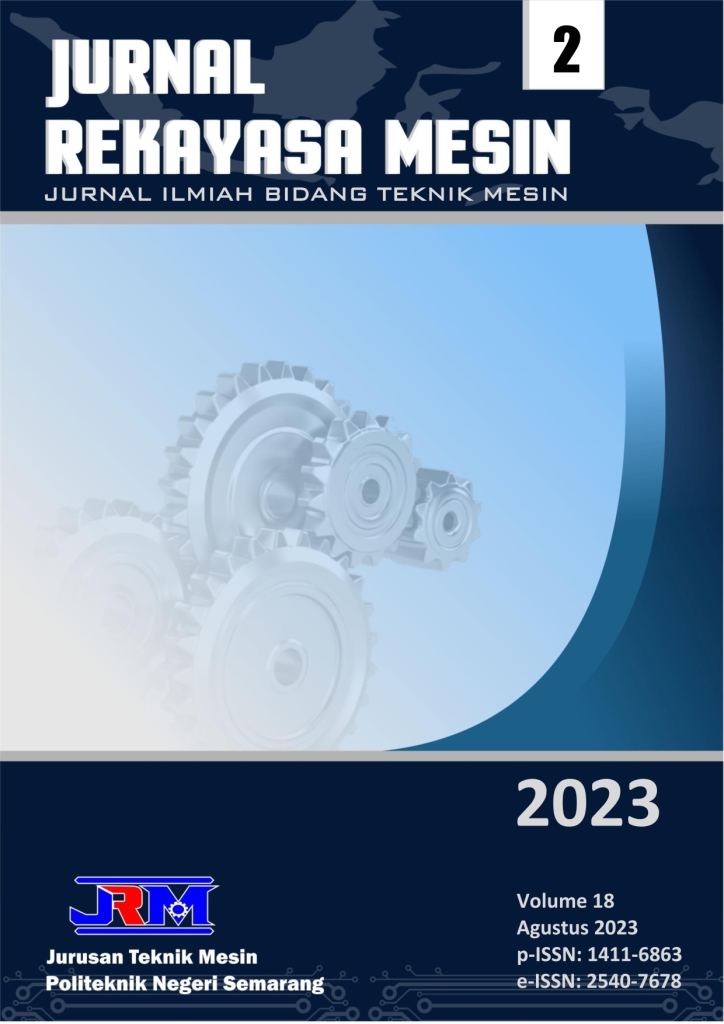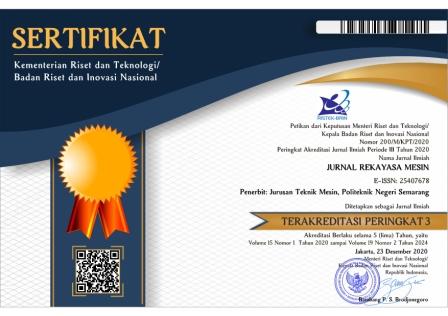The Characterization of Mechanical and Chemical Properties of Recycled Styrofoam Waste Employing Extrusion Process
DOI:
https://doi.org/10.32497/jrm.v18i2.4615Keywords:
extrusion, styrofoam waste, polystyrene, tensile test, impact testAbstract
Styrofoam waste is a polystyrene plastic-based waste in the form of foam with low density. Scavengers or recyclers are not interested in receiving styrofoam waste because of its light density which makes it ineffective in transportation and storage. Styrofoam waste can actually be converted into solid polystyrene products through a thermal-extrusion process but data regarding the optimum operating temperature and the characteristics of the resulting solid polystyrene products are not yet available. The purpose of this study was to investigate the properties of solid polystyrene products resulting from recycled styrofoam waste and determine the optimum temperature of the thermal-extrusion treatment process to be compared with the characteristics of the original polystyrene based on the results of tensile and impact tests. In this study, the processing was carried out using the thermal-extrusion method; Styrofoam is melted and extruded into a mold to produce polystyrene solids. The research was carried out with variations in extrusion temperature at 180 °C, 200 °C, and 220 °C. The polystyrene solids are then molded into tensile and impact test specimens by injection molding. The results showed that the optimal extrusion temperature was 200 °C with tensile and impact strength values of 27.55 MPa and 1,069 j/m2, respectively. Compared to the original polystyrene, the tensile strength value is 25.3% lower and the impact strength value is 29.5% lower. The decrease in the tensile and impact strength values is due to the shortening of the molecular bonds in the recycled polystyrene during the thermal-extrusion treatment process. Even though the tensile strength and impact are still lower, the use of styrofoam waste using the thermal-extrusion method has the potential to be developed at the production and commercialization stage because the resulting product has good economic value and can also reduce the use of original polystyrene and at the same time can solve the problem of styrofoam waste.
References
Jirawattanasomkul T, Likitlersuang S, Wuttiwannasak N, Varabuntoonvit V, Yodsudjai W, Ueda T. Fibre-reinforced polymer made from plastic straw for concrete confinement: An alternative method of managing plastic waste from the COVID-19 pandemic. Eng J. 2021;25(3):1”“14.
Tukker A, Barbarossa V. Resources , Conservation & Recycling Recycled plastic packaging from the Dutch food sector pollutes Asian oceans. 2022;185(July).
Samper MD, Garcia-Sanoguera D, Parres F, López J. Recycling of expanded polystyrene from packaging. Prog Rubber, Plast Recycl Technol. 2010;26(2):83”“92.
Hidalgo-Crespo J, Moreira CM, Jervis FX, Soto M, Amaya JL, Banguera L. Circular economy of expanded polystyrene container production: Environmental benefits of household waste recycling considering renewable energies. Energy Reports [Internet]. 2022;8:306”“11. Available from: https://doi.org/10.1016/j.egyr.2022.01.071
Almusawi A, Lachat R, Atcholi KE, Bi STIÉ. Manufacturing and Characterisation of Thermoplastic Composite of Hemp Shives and recycled Expanded Polystyrene Manufacturing and Characterisation of Thermoplastic Composite of Hemp Shives and recycled Expanded Polystyrene. 2019;(July 2016):1”“6.
Ward CP, Armstrong CJ, Walsh AN, Jackson JH, Reddy CM. Sunlight Converts Polystyrene to Carbon Dioxide and Dissolved Organic Carbon. Environ Sci Technol Lett. 2019;6(11):669”“74.
Huang Z, Shanmugam M, Liu Z, Brookfield A, Bennett EL, Guan R, et al. Chemical Recycling of Polystyrene to Valuable Chemicals via Selective Acid-Catalyzed Aerobic Oxidation under Visible Light. J Am Chem Soc. 2022;144(14):6532”“42.
Susmanto P, Cundari L, Putri RW, Ibrahim O, Oktari D. PENGARUH WAKTU DAN TEMPERATUR TERHADAP SIFAT FISIK CAIRAN HASIL PROSES PERENGKAHAN LIMBAH PLASTIK JENIS EXPANDED POLYSTYRENE. :123”“8.
Donbebe W, Dikio ED. Comparative study of polystyrene and polymethylmethacrylate waste as adsorbents for sorption of Pb2+ from aqueous solution. 2014;(December 2016).
Series C. Resistance to compression of conventional concrete alleviated through partial substitution of coarse aggregate for expanded polystyrene Resistance to compression of conventional concrete alleviated through partial substitution of coarse aggregate for expa. 2018;
Science E. Progresses in Polystyrene Biodegradation and Prospects for Solutions to Plastic Waste Pollution Progresses in Polystyrene Biodegradation and Prospects for Solutions to Plastic Waste Pollution. 2018;
Nukmal N, Umar S, Amanda SP, Kanedi M. Effect of Styrofoam Waste Feeds on the Growth , Development and Fecundity of Mealworms ( Tenebrio molitor ). 2018;24”“8.
Siyal AN, Memon SQ, Khuhawar MY. Recycling of styrofoam waste: Synthesis, characterization and application of novel phenyl thiosemicarbazone surface. Polish J Chem Technol. 2012;14(4):11”“8.
Fitidarini NL, Damanhuri E. Timbulan Sampah Styrofoam di Kota Bandung. J Tek Lingkung. 2011;17(2):87”“97.
Fikri E, Veronica A. Efektivitas Penurunan Konsentrasi Karbon Monoksida (CO) dengan Sistem Kontak Media Karbon Aktif Menggunakan Variasi Ukuran Partikel Pada Proses Pembakaran Sampah Polistirena Foam. J Kesehat Lingkung Indones. 2018;17(1):32.
Murtadho A, Triyono B, Eka D, Arifin S, Kunci K. Perancangan Alat Pengolah Sampah Expanded Polystyrene Foam ( EPS ) Portabel untuk Mengatasi Masalah Sampah di Sektor Rumah Tangga. Pros 12th Ind Res Work Natl Semin. 2021;12:388”“93.
Noguchi T, Miyashita M, Lnagaki Y, Watanabe H. A new recycling system for expanded polystyrene using a natural solvent. Part 1. A new recycling technique. Packag Technol Sci. 1998;11(1):19”“27.
Mahmudi A, Londa P. Optimasi Penerapan Teknologi Ekstrusi pada Prototipe Mesin Daur Ulang Limbah Styrofoam. Rotasi. 2017;19(2):92.
Haile L. Study of Recycling of Waste High Impact Polystyrene (PS-HI) and Polystyrene with Flame Retardant Additives (PS-FR) Co-Polymers. J Text Sci Fash Technol. 2021;7(4):1”“11.
Umamaheswari S. FTIR analysis of bacterial mediated chemical changes in Polystyrene foam. 2016;(June).
Tran ATK, Pham TT, Nguyen QH, Hoang NTT, Bui DT, Nguyen MT, et al. From waste disposal to valuable material: Sulfonating polystyrene waste for heavy metal removal. J Environ Chem Eng [Internet]. 2020;8(5):104302. Available from: https://doi.org/10.1016/j.jece.2020.104302
Wu H Der, Wu SC, Wu I Der, Chang FC. Novel determination of the crystallinity of syndiotactic polystyrene using FTIR spectrum. Polymer (Guildf). 2001;42(10):4719”“25.
Niculăescu C, Olar L, Stefan R, Todica M, Pop CV. XRD and IR investigations of some commercial polystyrene samples thermally degraded. Stud Univ Babes-Bolyai Chem. 2018;63(2):63”“70.
Sattar MA, Najeeb M, Mahdi SH, Fadil NQ. The effect of heat treatment on the degree of crystallinity and grain size for (N6, PS) polymers. J Xi”™an Univ Archit Technol [Internet]. 2020;12(3):4319”“25. Available from: http://www.xajzkjdx.cn/gallery/388-mar2020.pdf
Downloads
Published
How to Cite
Issue
Section
License
Copyright of articles that appear in Jurnal Rekayasa Mesin belongs exclusively to Penerbit Jurusan Teknik Mesin Politeknik Negeri Semarang. This copyright covers the rights to reproduce the article, including reprints, electronic reproductions, or any other reproductions of similar nature.







